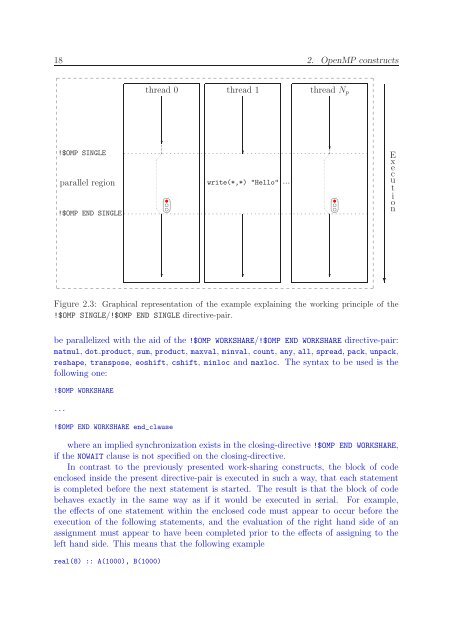Parallel Programming in Fortran 95 using OpenMP - People
Parallel Programming in Fortran 95 using OpenMP - People
Parallel Programming in Fortran 95 using OpenMP - People
You also want an ePaper? Increase the reach of your titles
YUMPU automatically turns print PDFs into web optimized ePapers that Google loves.
18 2. <strong>OpenMP</strong> constructs<br />
thread 0 thread 1 thread N p<br />
!$OMP SINGLE<br />
❄<br />
❄<br />
❄<br />
E xecution<br />
parallel region<br />
write(*,*) "Hello"<br />
...<br />
!$OMP END SINGLE<br />
✞<br />
☎<br />
✝❝<br />
✆<br />
✞<br />
☎<br />
✝❝<br />
✆<br />
❄ ❄ ❄<br />
❄<br />
Figure 2.3: Graphical representation of the example expla<strong>in</strong><strong>in</strong>g the work<strong>in</strong>g pr<strong>in</strong>ciple of the<br />
!$OMP SINGLE/!$OMP END SINGLE directive-pair.<br />
be parallelized with the aid of the !$OMP WORKSHARE/!$OMP END WORKSHARE directive-pair:<br />
matmul, dot product, sum, product, maxval, m<strong>in</strong>val, count, any, all, spread, pack, unpack,<br />
reshape, transpose, eoshift, cshift, m<strong>in</strong>loc and maxloc. The syntax to be used is the<br />
follow<strong>in</strong>g one:<br />
!$OMP WORKSHARE<br />
...<br />
!$OMP END WORKSHARE end_clause<br />
where an implied synchronization exists <strong>in</strong> the clos<strong>in</strong>g-directive !$OMP END WORKSHARE,<br />
if the NOWAIT clause is not specified on the clos<strong>in</strong>g-directive.<br />
In contrast to the previously presented work-shar<strong>in</strong>g constructs, the block of code<br />
enclosed <strong>in</strong>side the present directive-pair is executed <strong>in</strong> such a way, that each statement<br />
is completed before the next statement is started. The result is that the block of code<br />
behaves exactly <strong>in</strong> the same way as if it would be executed <strong>in</strong> serial. For example,<br />
the effects of one statement with<strong>in</strong> the enclosed code must appear to occur before the<br />
execution of the follow<strong>in</strong>g statements, and the evaluation of the right hand side of an<br />
assignment must appear to have been completed prior to the effects of assign<strong>in</strong>g to the<br />
left hand side. This means that the follow<strong>in</strong>g example<br />
real(8) :: A(1000), B(1000)
















